10 Types of Salamanders
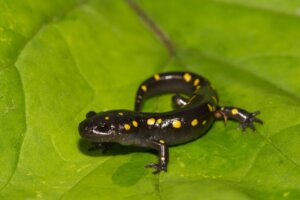

Written and verified by the biologist Cesar Paul Gonzalez Gonzalez
Salamanders are part of the caudate group of amphibians, which have a tail throughout their life stages. Like their closest relatives, these organisms need environments with high humidity to survive, as part of their respiration is carried out through the skin. Although their distribution is somewhat limited, this doesn’t prevent the existence of several different types of salamanders.
The term salamander is used to name different species of amphibians. However, in this space only two families will be considered: Salamandridae and Plethodontidae. Read on and get to know 10 different types of salamanders with us.
Family Salamandridae
This group consists of the salamanders, which are also called newts. Currently, 114 species are recognized worldwide with a distribution spanning Asia, Africa, North America and Europe. In addition, most of these amphibians are characterized by lungs, so they are able to breathe well out of water.
The physical form of these organisms closely resembles that of lizards, with the major difference being that their skin has no scales and feels moist to the touch. In addition, some species may even have mildly venomous toxins and exhibit bright aposematic colorations. Some types of salamanders in this family are listed below.
1. Gold-striped salamander (Chioglossa lusitanica)
The gold-striped salamander is a slender, elongated animal with a tail that can reach twice the size of the body. On the other hand, its skin is smooth and very shiny, although its colors are dark and spots appear in some specimens. These amphibians are endemic to the Iberian Peninsula, with Asturias being the region with the most sightings.
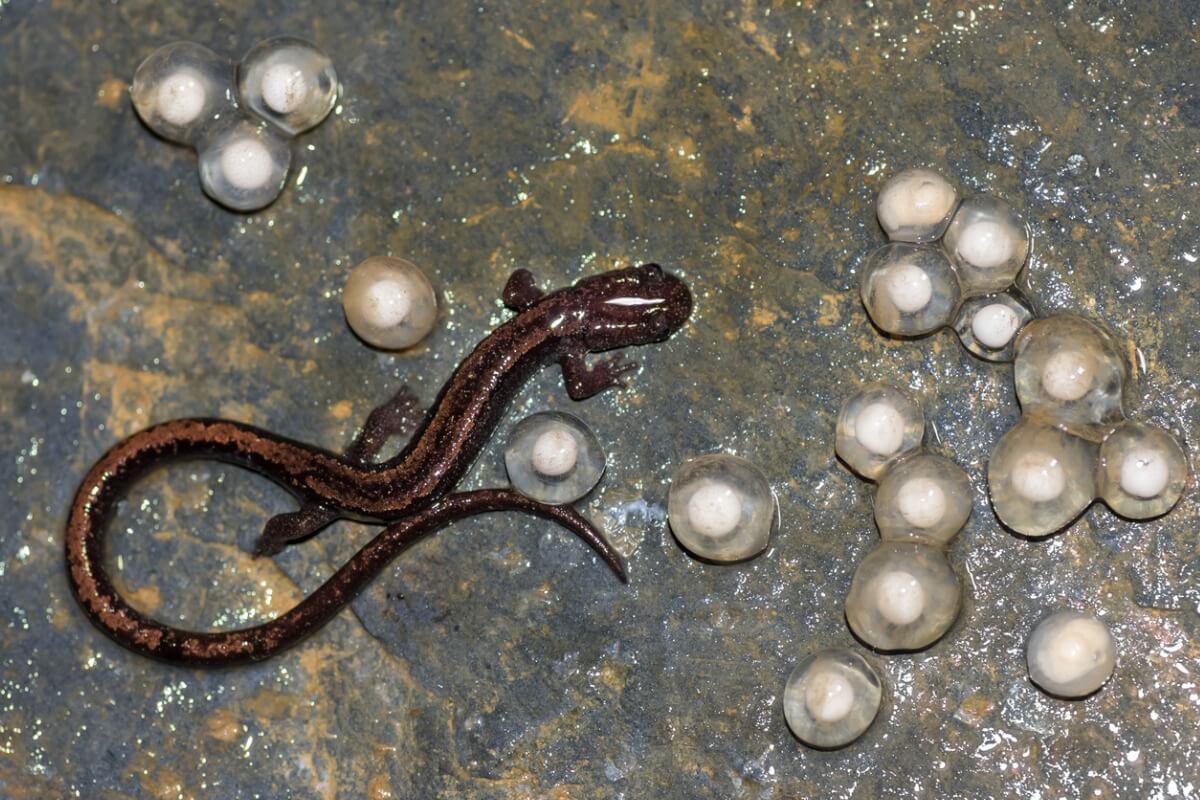
2. Iberian ribbed newt (Pleurodeles waltl)
The Iberian-ribbed newt is a rather strange amphibian, as it has a peculiar defense mechanism. Almost in the style of a science fiction movie, this organism sticks its ribs out of its sides in order to “stab” its predators and inject them with toxins. This species is distributed over part of the Iberian Peninsula and western Morocco.
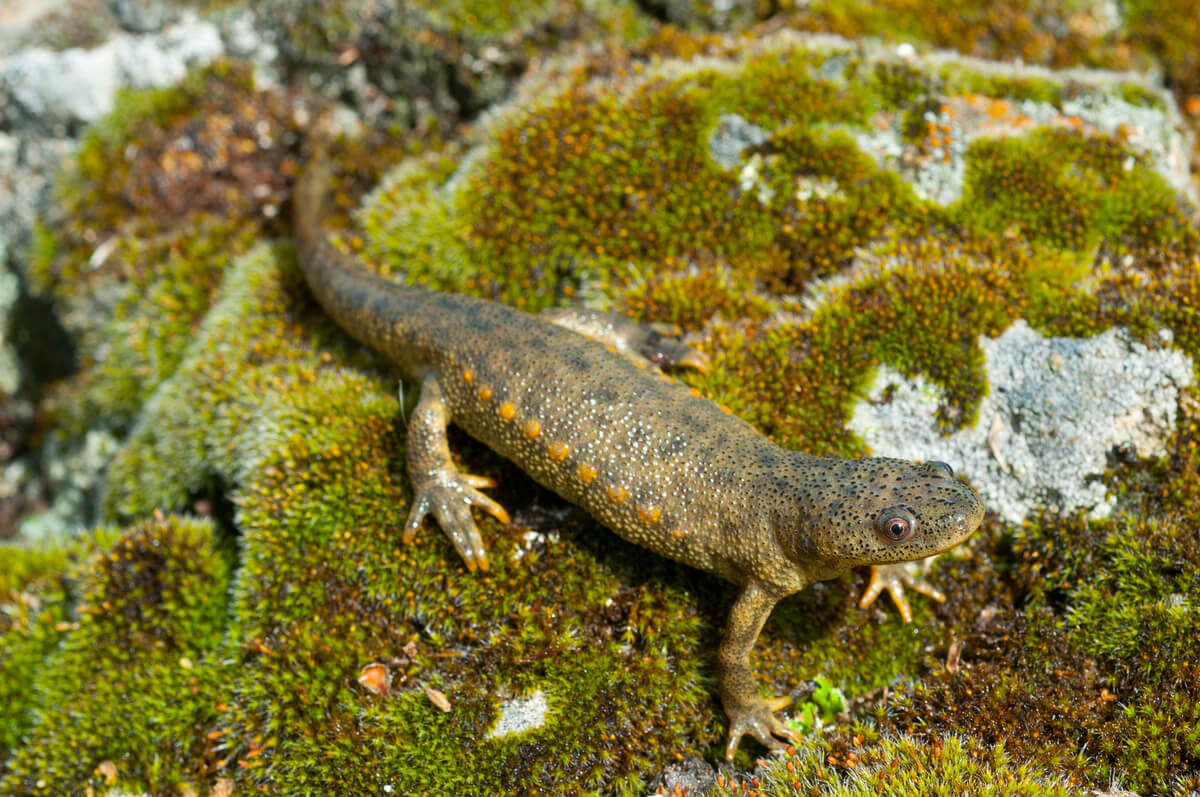
3. Crocodile newt (Tylototriton verrucosus)
This newt is known to inhabit the mountains of Southeast India, Bhutan, Nepal, Burma, Thailand and China. It lives between 1200 and 2250 meters above sea level near streams, brooks or ponds. The scientific name of the species comes from the light-colored warts on the sides of its body, which resemble those of a crocodilian.

4. Luristan newt (Neurergus kaiseri)
This animal is quite colorful and peculiar, as its skin exhibits a combination of bright colors such as red, orange, black and white. The species is native to Mount Zagros (Iran), where it can only be found in a few rivers. Due to its exotic appearance it has been the victim of capture and trade, which has led to a marked reduction in its population.
5. Chinese fire-bellied newt (Cynops orientalis)
The fire-bellied newt is named for the aposematic hue of its belly, which exhibits bright red colors with disruptive pits. The dorsum of this organism isn’t at all showy, exhibiting black or dark tones. These specimens are endemic to China, where they’re classified as a threatened species due to habitat destruction.
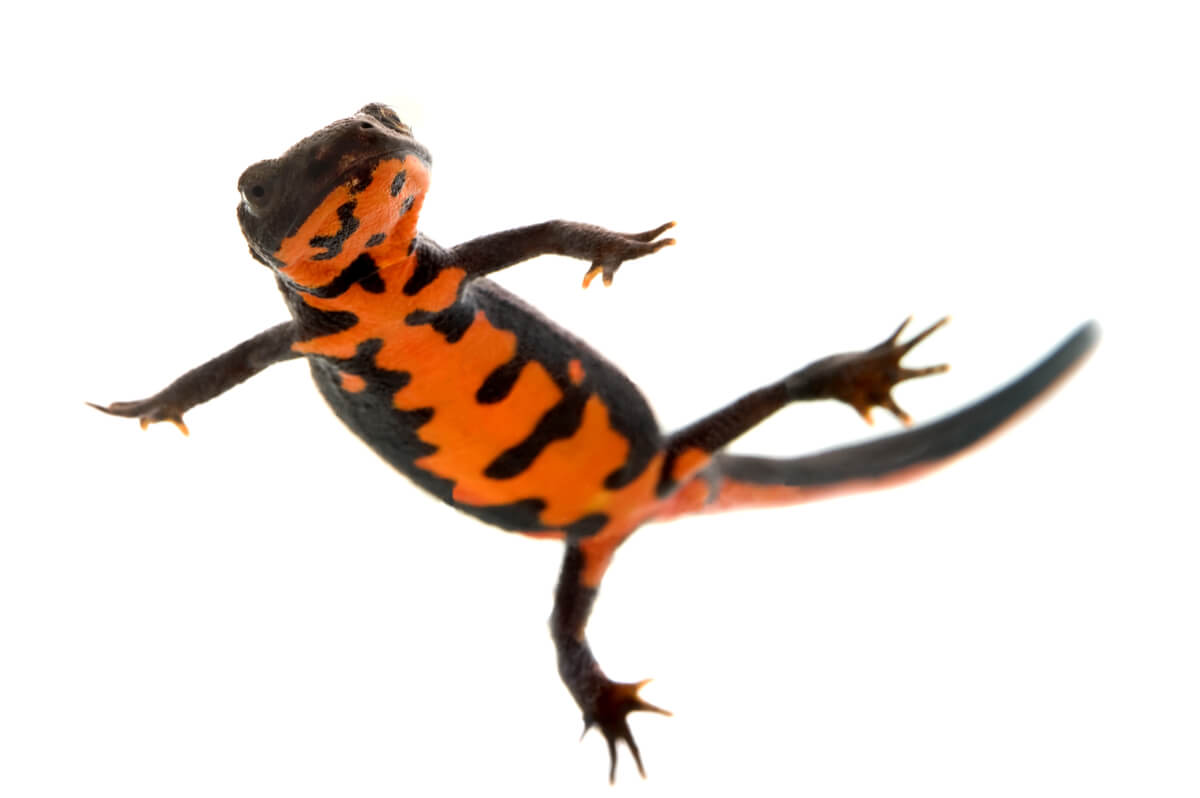
Family Plethodontidae
Plethodontids are also considered salamanders, as they share certain features with the salamanders mentioned above. However, they don’t have developed lungs like the previous species. For this reason, their sizes are usually small and they breathe through the skin. The following list groups some types of apulmonate (lungless) salamanders in this group.
6. Van Dyke’s salamander (Plethodon vandykei)
This is a small salamander that lives in wet forests with streams, as it needs a lot of moisture to breathe through its skin. In addition, its limbs are more elongated than normal, which also includes its tail. On the other hand, its body exhibits a combination of black, yellow, pink and red colors. These organisms only live in western Washington (USA).
7. Arboreal salamander (Aneides lugubris)
The arboreal salamander is named for the habitat it prefers to live in, as it is characterized by a prehensile tail that makes it an excellent climber. It shelters during the day inside tree cavities while it waits for nightfall to come out to hunt insects and other invertebrates. These specimens are native to North America.
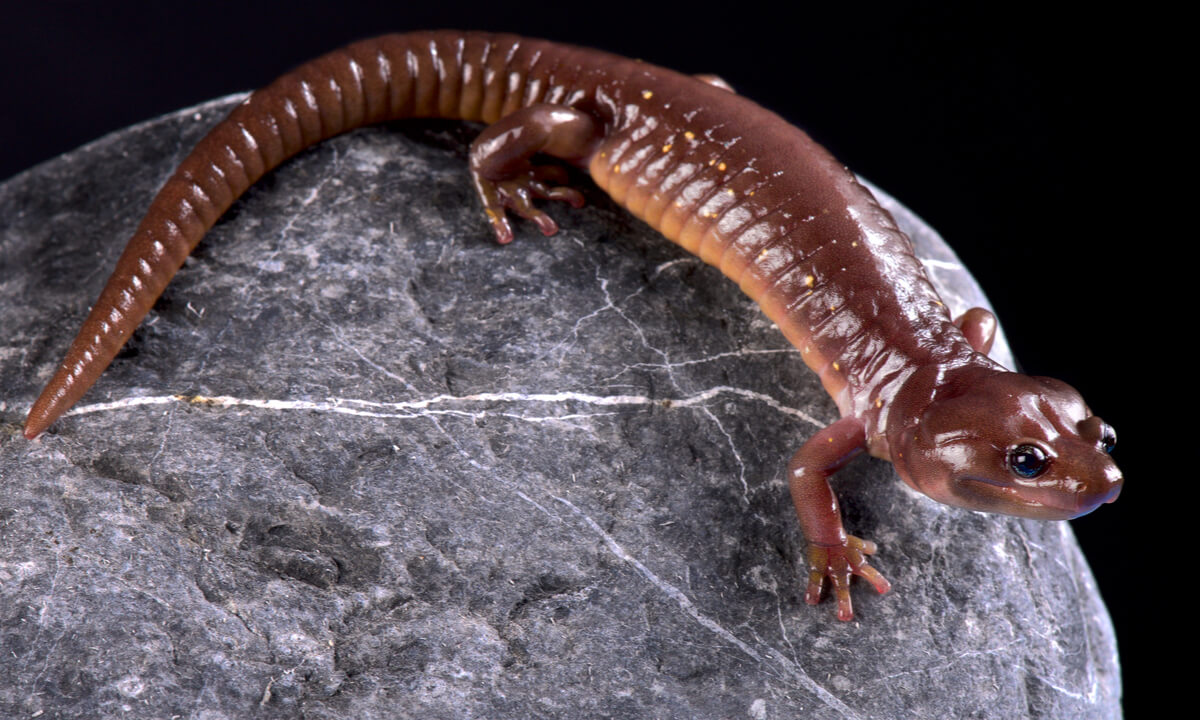
8. Red-legged salamander (Plethodon shermani)
As its name suggests, this type of salamander exhibits dark colors on its body, while its limbs have bright red tones. In addition, these amphibians cluster in moderately cold habitats in mountains such as Unicoi, Nantahala, and the Appalachian Mountains.
9. Nimble long-legged salamander (Nyctanolis pernix)
These organisms are endemic to Guatemala and Mexico, where they occupy diverse cloud forests to live. Among their most distinctive characteristics are their elongated limbs, which, if stretched along the body, overlap. Thanks to this, the specimens are more agile and have better mobility than others in their family.
10. Ambrosi’s cave salamander (Speleomantes ambrosii)
The Ambrosi’s cave salamander is endemic to Italy and is distributed in a small region of the province of La Spezia. Despite its name, this amphibian doesn’t live specifically in caves, since it’s also found under stones or forest litter. Its coloration varies between black and brown tones with gray, green, red, pink or brown spots.
Despite needing a humid area to live, salamanders have been able to diversify almost everywhere in the world. However, like many other amphibians, the greatest threat they face is habitat loss. Humans are, and will be, the cause of many of these fascinating animals being on the brink of extinction.
Salamanders are part of the caudate group of amphibians, which have a tail throughout their life stages. Like their closest relatives, these organisms need environments with high humidity to survive, as part of their respiration is carried out through the skin. Although their distribution is somewhat limited, this doesn’t prevent the existence of several different types of salamanders.
The term salamander is used to name different species of amphibians. However, in this space only two families will be considered: Salamandridae and Plethodontidae. Read on and get to know 10 different types of salamanders with us.
Family Salamandridae
This group consists of the salamanders, which are also called newts. Currently, 114 species are recognized worldwide with a distribution spanning Asia, Africa, North America and Europe. In addition, most of these amphibians are characterized by lungs, so they are able to breathe well out of water.
The physical form of these organisms closely resembles that of lizards, with the major difference being that their skin has no scales and feels moist to the touch. In addition, some species may even have mildly venomous toxins and exhibit bright aposematic colorations. Some types of salamanders in this family are listed below.
1. Gold-striped salamander (Chioglossa lusitanica)
The gold-striped salamander is a slender, elongated animal with a tail that can reach twice the size of the body. On the other hand, its skin is smooth and very shiny, although its colors are dark and spots appear in some specimens. These amphibians are endemic to the Iberian Peninsula, with Asturias being the region with the most sightings.

2. Iberian ribbed newt (Pleurodeles waltl)
The Iberian-ribbed newt is a rather strange amphibian, as it has a peculiar defense mechanism. Almost in the style of a science fiction movie, this organism sticks its ribs out of its sides in order to “stab” its predators and inject them with toxins. This species is distributed over part of the Iberian Peninsula and western Morocco.

3. Crocodile newt (Tylototriton verrucosus)
This newt is known to inhabit the mountains of Southeast India, Bhutan, Nepal, Burma, Thailand and China. It lives between 1200 and 2250 meters above sea level near streams, brooks or ponds. The scientific name of the species comes from the light-colored warts on the sides of its body, which resemble those of a crocodilian.

4. Luristan newt (Neurergus kaiseri)
This animal is quite colorful and peculiar, as its skin exhibits a combination of bright colors such as red, orange, black and white. The species is native to Mount Zagros (Iran), where it can only be found in a few rivers. Due to its exotic appearance it has been the victim of capture and trade, which has led to a marked reduction in its population.
5. Chinese fire-bellied newt (Cynops orientalis)
The fire-bellied newt is named for the aposematic hue of its belly, which exhibits bright red colors with disruptive pits. The dorsum of this organism isn’t at all showy, exhibiting black or dark tones. These specimens are endemic to China, where they’re classified as a threatened species due to habitat destruction.

Family Plethodontidae
Plethodontids are also considered salamanders, as they share certain features with the salamanders mentioned above. However, they don’t have developed lungs like the previous species. For this reason, their sizes are usually small and they breathe through the skin. The following list groups some types of apulmonate (lungless) salamanders in this group.
6. Van Dyke’s salamander (Plethodon vandykei)
This is a small salamander that lives in wet forests with streams, as it needs a lot of moisture to breathe through its skin. In addition, its limbs are more elongated than normal, which also includes its tail. On the other hand, its body exhibits a combination of black, yellow, pink and red colors. These organisms only live in western Washington (USA).
7. Arboreal salamander (Aneides lugubris)
The arboreal salamander is named for the habitat it prefers to live in, as it is characterized by a prehensile tail that makes it an excellent climber. It shelters during the day inside tree cavities while it waits for nightfall to come out to hunt insects and other invertebrates. These specimens are native to North America.

8. Red-legged salamander (Plethodon shermani)
As its name suggests, this type of salamander exhibits dark colors on its body, while its limbs have bright red tones. In addition, these amphibians cluster in moderately cold habitats in mountains such as Unicoi, Nantahala, and the Appalachian Mountains.
9. Nimble long-legged salamander (Nyctanolis pernix)
These organisms are endemic to Guatemala and Mexico, where they occupy diverse cloud forests to live. Among their most distinctive characteristics are their elongated limbs, which, if stretched along the body, overlap. Thanks to this, the specimens are more agile and have better mobility than others in their family.
10. Ambrosi’s cave salamander (Speleomantes ambrosii)
The Ambrosi’s cave salamander is endemic to Italy and is distributed in a small region of the province of La Spezia. Despite its name, this amphibian doesn’t live specifically in caves, since it’s also found under stones or forest litter. Its coloration varies between black and brown tones with gray, green, red, pink or brown spots.
Despite needing a humid area to live, salamanders have been able to diversify almost everywhere in the world. However, like many other amphibians, the greatest threat they face is habitat loss. Humans are, and will be, the cause of many of these fascinating animals being on the brink of extinction.
All cited sources were thoroughly reviewed by our team to ensure their quality, reliability, currency, and validity. The bibliography of this article was considered reliable and of academic or scientific accuracy.
- Kieren, S., Sparreboom, M., Hochkirch, A., & Veith, M. (2018). A biogeographic and ecological perspective to the evolution of reproductive behaviour in the family Salamandridae. Molecular phylogenetics and evolution, 121, 98-109.
- Vences, M. (2015). Salamandra rabilarga – Chioglossa lusitanica. En: Enciclopedia Virtual de los Vertebrados Españoles. Salvador, A., Martínez-Solano, I. (Eds.). Museo Nacional de Ciencias Naturales, Madrid. http://www.vertebradosibericos.org/
- Kuzmin, S. L., Dasgupta, R., & Smirina, E. M. (1994). Ecology of the Himalayan newt (Tylototriton verrucosus) in Darjeeling himalayas, India. Russian Journal of Herpetology, 1(1), 69-76.
- Guo, K., Yuan, S., Wang, H., Zhong, J., Wu, Y., Chen, W., … & Chang, Q. (2021). Species distribution models for predicting the habitat suitability of Chinese fire‐bellied newt Cynops orientalis under climate change. Ecology and evolution, 11(15), 10147-10154.
- Nishikawa, K., Khonsue, W., Pomchote, P., & Matsui, M. (2013). Two new species of Tylototriton from Thailand (amphibia: Urodela: Salamandridae). Zootaxa, 3737(3), 261-279.
- Brodie Jr, E. D., & Storm, R. M. (1970). Plethodon vandykei. Catalogue of American Amphibians and Reptiles (CAAR).
This text is provided for informational purposes only and does not replace consultation with a professional. If in doubt, consult your specialist.








